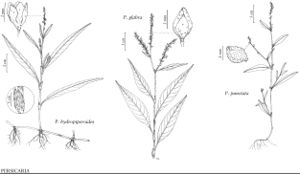Difference between revisions of "Persicaria glabra"
Anales Inst. Segunda Enseñ. 2: 278. 1896.
FNA>Volume Importer |
imported>Volume Importer |
||
| Line 8: | Line 8: | ||
}} | }} | ||
|common_names=Smooth smartweed | |common_names=Smooth smartweed | ||
| + | |special_status={{Treatment/ID/Special_status | ||
| + | |code=F | ||
| + | |label=Illustrated | ||
| + | }} | ||
|basionyms={{Treatment/ID/Basionym | |basionyms={{Treatment/ID/Basionym | ||
|name=Polygonum glabrum | |name=Polygonum glabrum | ||
| Line 69: | Line 73: | ||
|publication title=Anales Inst. Segunda Enseñ. | |publication title=Anales Inst. Segunda Enseñ. | ||
|publication year=1896 | |publication year=1896 | ||
| − | |special status= | + | |special status=Illustrated |
| − | |source xml=https:// | + | |source xml=https://bibilujan@bitbucket.org/aafc-mbb/fna-data-curation.git/src/bb6b7e3a7de7d3b7888a1ad48c7fd8f5c722d8d6/coarse_grained_fna_xml/V5/V5_1196.xml |
|subfamily=Polygonaceae subfam. Polygonoideae | |subfamily=Polygonaceae subfam. Polygonoideae | ||
|genus=Persicaria | |genus=Persicaria | ||
Revision as of 00:30, 28 May 2020
Plants perennial, 3–15 dm; roots also often arising from proximal nodes; rhizomes present. Stems decumbent to erect, usually branched distally, without noticeable ribs, glabrous or, rarely, pubescent distally, sometimes glandular-punctate. Leaves: ocrea light brown, cylindric, 12–23 mm, chartaceous, base inflated, margins truncate, eciliate, surface glabrous, usually obscurely glandular-punctate; petiole 0.2–2 cm, scabrous; blade without dark triangular or lunate blotch adaxially, lanceolate, (10–)15–30 × (1.5–)2–5.4 cm, base tapered, margins glabrous or antrorsely strigose, apex acute to acuminate, faces glabrous or scabrous along midveins, sometimes glandular-punctate. Inflorescences mostly terminal, sometimes also axillary, erect to slightly nodding, usually uninterrupted, 30–100 × 5–9 mm; peduncle 10–50 mm, glabrous or scabrid, glandular-punctate; ocreolae usually overlapping, margins eciliate. Pedicels erect to spreading, 2–5 mm. Flowers (1–)3–8 per ocreate fascicle, homostylous; perianth greenish white to white or pink, glabrous, not glandular-puncate or glandular-punctate with punctae ± uniformly distributed, scarcely accrescent; tepals 5, connate ca. 1/3 their length, obovate, 3–3.6 mm, veins not prominent, not anchor shaped, margins entire, apex obtuse to rounded; stamens 5–7, included; anthers pink or red, ovate; styles 2, connate proximally. Achenes included, dark brown to brownish black, biconvex, 2–2.2 × 1.3–1.6 mm, shiny, smooth.
Phenology: Flowering Aug–Nov.
Habitat: Swamps, wet thickets, marshy shores, frequently in water, mostly on coastal plain of e North America
Elevation: 0-300
Distribution

Ala., Ark., Del., Fla., Ga., Ky., La., Md., Miss., Mo., N.J., N.C., S.C., Tenn., Tex., Va., Central America, South America, Asia, ne Africa, Pacific Islands (Hawaii, Philippines).
Discussion
American plants here included in Persicaria glabra often have been treated as distinct and called P. densiflora. The morphological differences between them and Asian and Pacific P. glabra are minor. Regional tendencies exist but do not appear sufficient to warrant separation of the species (K. L. Wilson 1990b).
An infusion made from pounded whole plants was used by the Hawaiians as a blood medicine (D. E. Moerman 1998).
Selected References
None.
